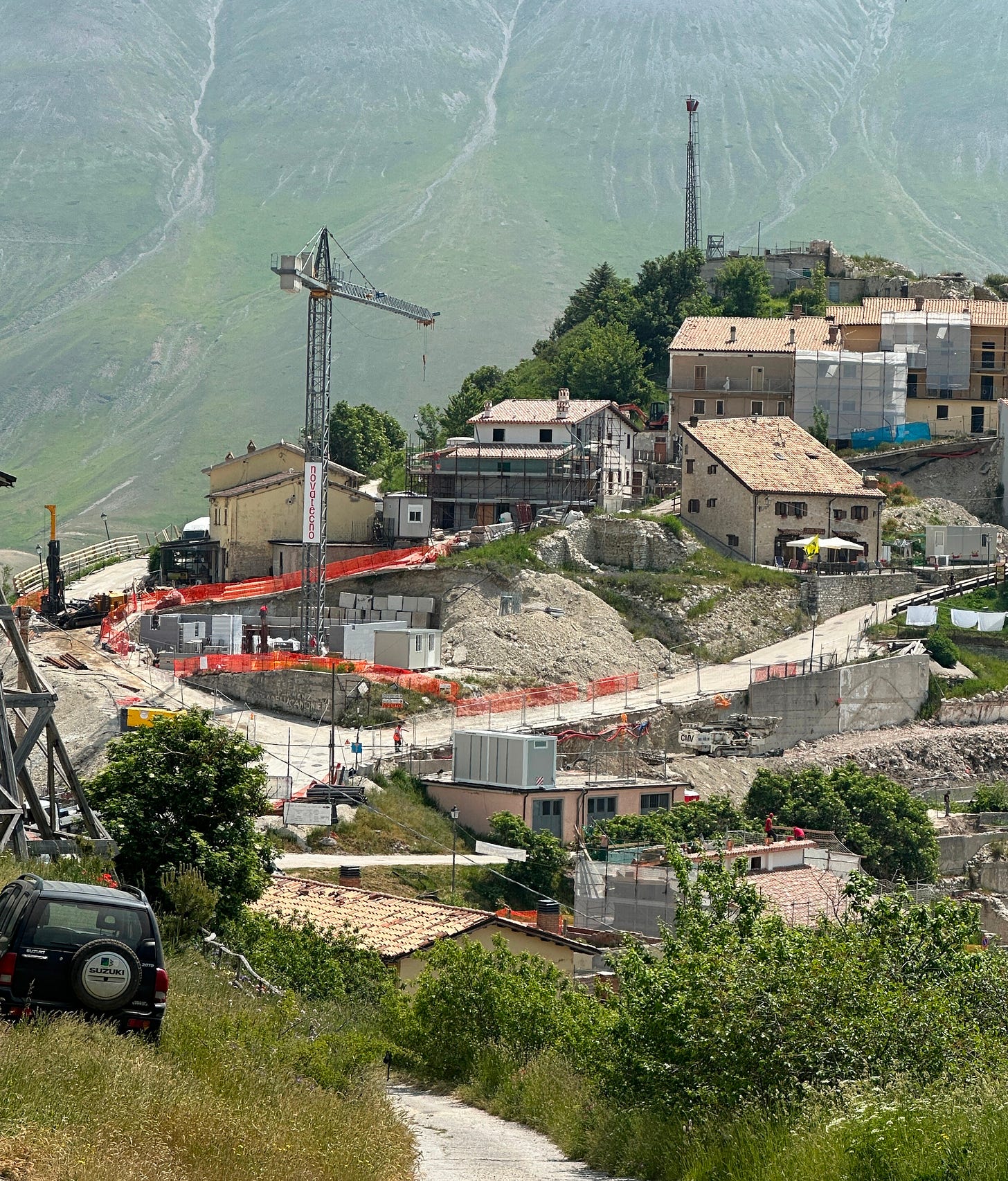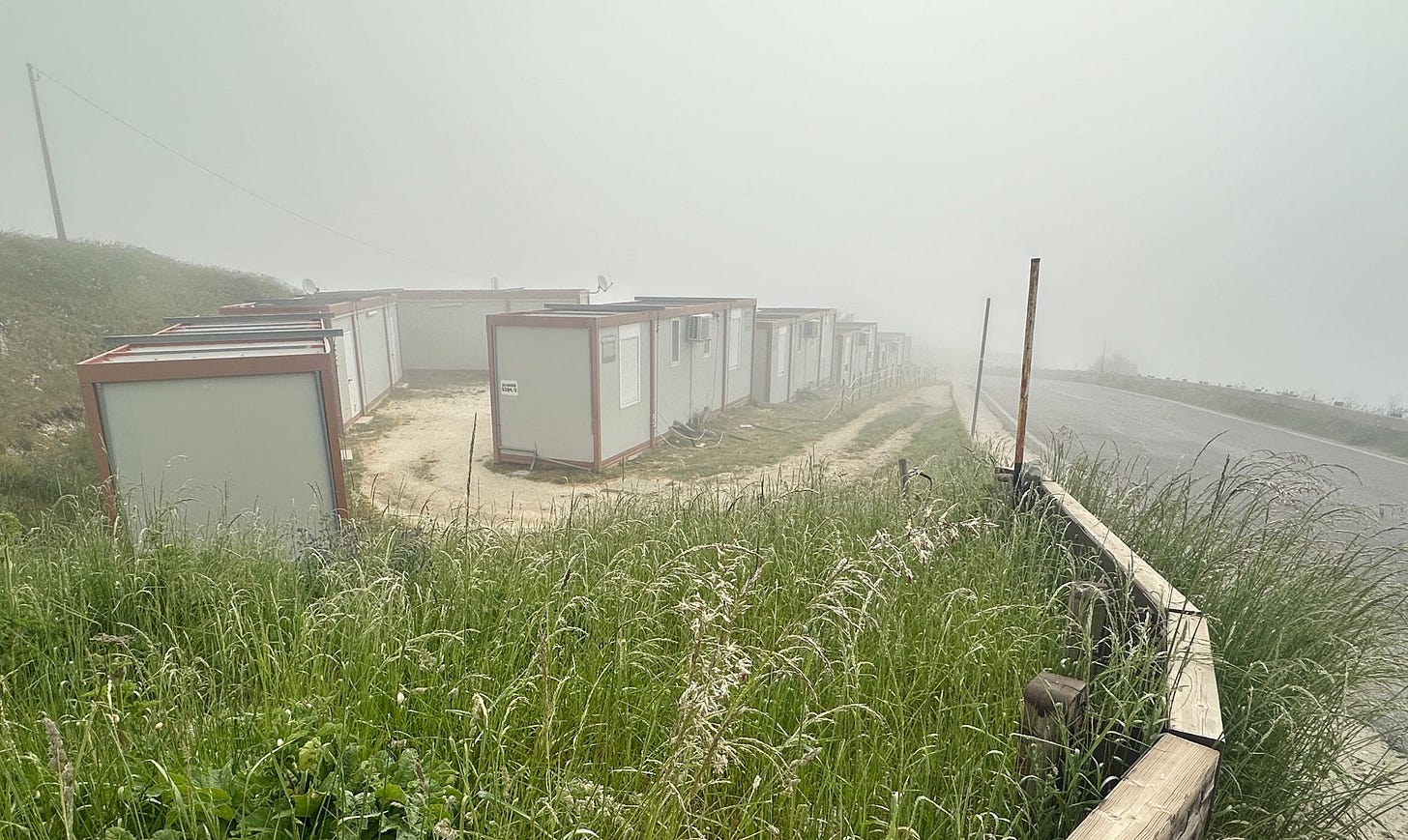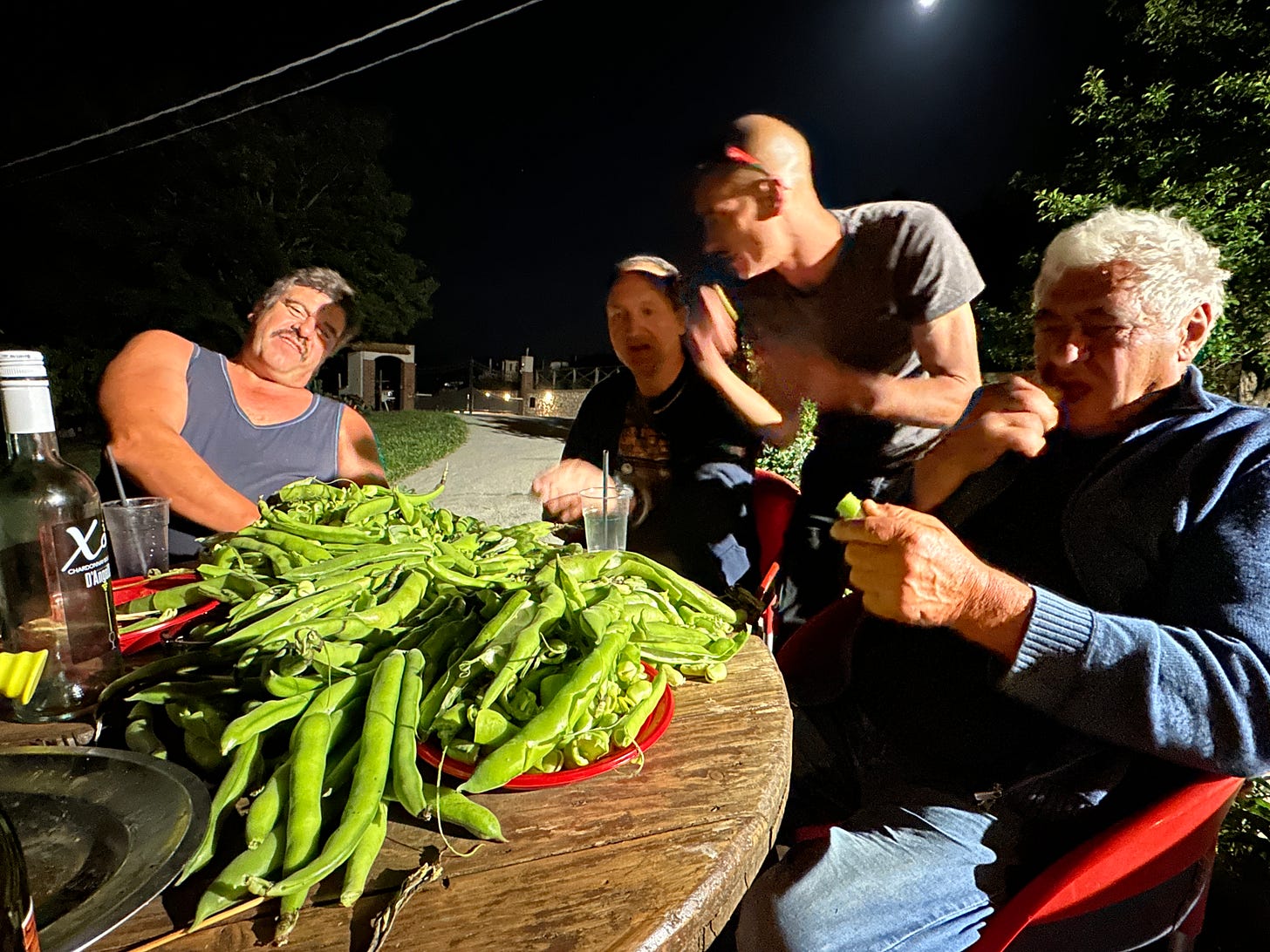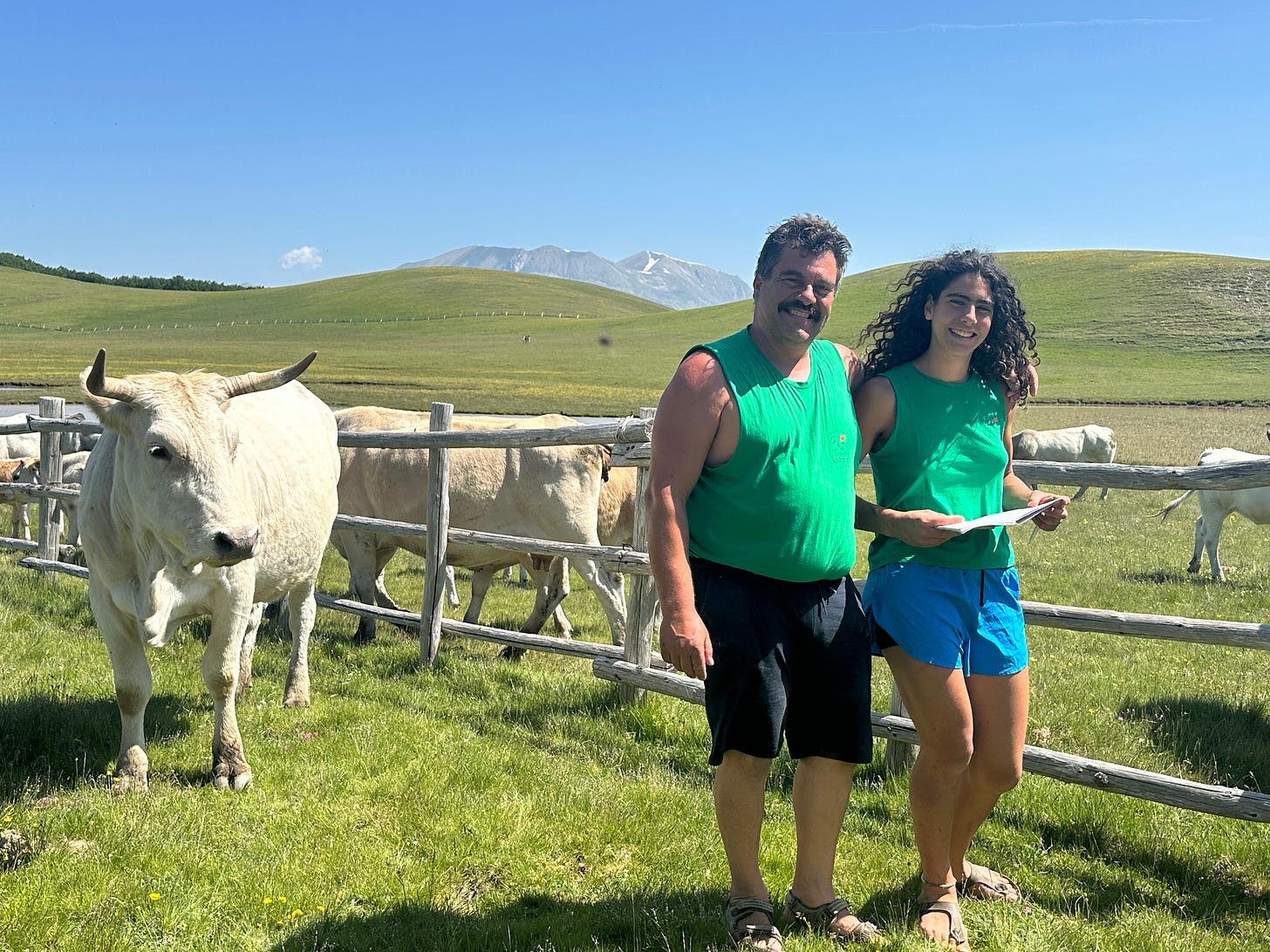Five days on the trail brought us through alpine meadows, across rocky ridgelines, and face-to-face with wild chamois (Rupicapra pyrenaica ornata) of Gran Sasso National Park, in Abruzzo region. It would be easy spend a lifetime here, in a park that encompasses dozens of mountain villages and farms that intertwine Italian culture with conservation in a way that emits a deep sense of place.
Monte Sibillini National Park to the north is similar, with one notable exception. It was shattered by a 6.2 magnitude earthquake in 2016. Even nine years later, the aftermath is heartbreaking—placid towns full of kind and passionate Italians turned to rubble, cranes dominating the skyline. I have labored through several disaster recovery efforts in my career (e.g., FEMA declared fires and floods) and lived through several earthquakes, including the 1989 earthquake of San Francisco. But there’s an element of the recovery effort here that carries a somber weight, yet tells an important story about what regionalismo is, and how it might be rebuilt.
The Socio-Economic Insight
For a variety of reasons, youth have been leaving many southern Italian regions to find more (or just different) job opportunities in Italy’s northern cities like Bologna, or in big northern European cities like London. The implications of this youth emigration include a loss of culture, weakened family ties, and a raw population decline in the hundreds of communities left behind. American farm towns went through a similar emigration disruption in the mid 20th century,1 as did America’s manufacturing cities decades later—in a region known today as the rust belt. But here, in this region of Italy, throw into the mix a catastrophic earthquake and the recovery effort takes on an entirely new dimension.
Castelluccio, Umbria, working tirelessly to rebuild in the aftermath of the 2016 earthquake. Photo by J.H. Giordanengo.
Temporary housing for residents of Castelluccio, Umbria region. Photo by J.H. Giordanengo
Restoring the Houses is the Easy Part (the community is another matter)
Buildings are simple physical structures, with basic rebuilding instructions. An entire Italian industry has evolved to restore ancient structures, while preserving the original character of each façade, column, and clay-tiled roof. When the work is done, the result is easy to see.
Restoring the “living” elements of society—culture, community, traditions—is far more challenging, and the result invisible. Yet, this is exactly what Katia D’Apostolo and her family at Alta Montagna Bio are working toward. After hiking through the rubble of Amatrice, Accumoli, and other earthquake-ravaged cities, Alta Montagna Bio felt out of place. Katia’s in-laws, Roberto Pica and his wife Rosanna, built this farm from the ground up—three stables, a herd of cattle (plus sheep, goats, chickens, and rabbits), a magnificent house, and a family-run meat and salumi production shop. Along the way, Roberto and Rosanna sowed into the fabric of this land the ancestral traditions that were imprinted on them as children.
I can grasp the simplest traditions: curing prosciutto, making vino cotto (cooked red wine), and eating fava beans by the bushel around a table, just talking and eating while the night sky inched across the ridgeline.
Eating fava beans with Katia’s husband Guido (left), his father Roberto (right), her cousin Manfredo (center right), and family friends at Alta Montagna Bio during the Festa of Santa Maria of the Hills. Photo by J.H. Giordanengo.
This entire hacienda was intact after the earthquake. And miraculously, so is the family, including four children who work on the farm: Barbara, Sofia, Elisa, and Roberto Jr. It was a rare treat to spend two days roaming the meadows and barns with the family. Elisa and her father Guido brought me up to the high pasture, in the heart of Monte Sibillini National Park. The ecologist in me couldn’t help but notice how healthy the vegetation is here, and the vibrant green beech forests surrounding the meadows. The raw human inside sniffed at the cool air, gazed at the blue sky over the mountains, and inhaled a deep peace.
Watching the cattle, high peaks in the distance, Guido rang a bell and pulled a bucket of feed from the jeep. Three different herds are intermingled in this pasture, but only his white cows came running, engulfing us in an instant. Elisa, 20, already had her notebook out, documenting as she walked with a pleasant confidence through the herd. She knows every animal by name, where they were born, who their parents were, and any issues they might have (none today).
Guido and Elisa Pica in upper pasture at Alta Montagna Bio, Lazio region. Photo by J.H. Giordanengo.
I asked Elisa what she likes about this work, and she remarked in a way that made me wonder why I asked in the first place. It seems clear, at least to an outsider, that Elisa and her siblings get a pure sense of joy from this regionalismo lifestyle—the intimate bonds they have with every animal, their close family ties, the diversity of daily tasks, and the tranquility of life in the high mountain air.
The most important cultural element, perhaps, is the very thing you cannot point a finger at; something Katia is deeply concerned with. But first, we would take another day’s rest from trekking, be grateful for the pleasure of fine company, and enjoy some farm-fresh cuisine, prepared with love—a reflection of the forebearers who cared for each other, these animals, and this land for generations. Then, perhaps, a bit more insight into regionalism might arise.
Summer Books and Fall Talks
For a deeper dive on restoring your economy, digital and paperback copies of Ecosystems as Models for Restoring our Economies (To a Sustainable State) are available at Anthem Press and just about anywhere else you shop for books.
Upcoming talks and workshops on economic restoration are listed here. If you’re interested in a talk in your neck of the woods, feel free to reach out to me through the contact page.
Notes
Keep in mind that the E.U. is about the same size as the U.S. (geographically), and emigrating from southern Italy to London, UK is a similar distance as migrating from, say, Fort Collins, Colorado to Los Angeles, California.







